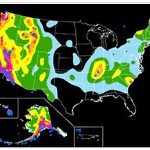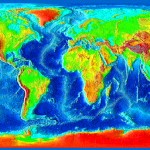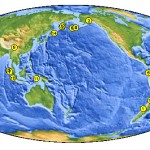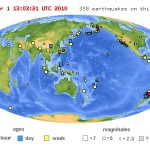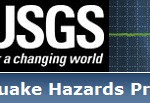They’re invisible, silent, and they can strike at any time. When they do, cars and houses get tossed around, and people become frightened. You’ll probably be less afraid of earthquakes if you know how they work. Here’s a test of your knowledge.
1. You’re in your house and it starts to shake. What should you do?
a) Run outside where nothing can fall on you.
b) Get under a desk or strong table.
c) Find a doorframe and stand under it.
Answers (b). See http://bit.ly/9Q0G2g and http://bit.ly/6t5Li.
2. True or False. The air starts to change right before an earthquake. It’s called “earthquake weather.”
False. Visit http://bit.ly/91VB8u and http://earthquake.usgs.gov/learn/facts.php.
3. True or False. There was recently an earthquake in Chicago.
True. On 2/10/2010 there was a small earthquake in Chicago. According to
the USGS, earthquakes can happen in 39 states; the risk is greatest in
California, Alaska and Hawaii. See http://bit.ly/91VB8u and http://earthquake.usgs.gov/learn/facts.php.
4. How fast do the continental plates move?
a) The speed of a person walking.
b) The speed that your fingernails growing.
c) The speed of a car driving.
Answer (b). See http://bit.ly/3UK8IL.
5. Where was the strongest earthquake ever recorded?
a) Chili in 1960.
b) Haiti in 2010.
c) San Francisco Earthquake of 1906.
Answer (a). Visit http://bit.ly/7pXaYK.
6. About how many recorded earthquakes occurred last week around the world?
a) 3
b) 30
c) 300
Answe (c). According to http://bit.ly/2o528P, earthquakes happen all the time. You just can’t feel all of them.
7. More.
Visit USGS for Kids http://bit.ly/5uBCY9 to learn more. Think of the Earth
as a cracked egg; with a hard shell (or crust) on the outside, and liquid
(or molten rock) in the inside. Now spin your egg on a table, and things
start moving. The parts of the shell will rub, slipping along the cracks (or
faults), and some of the liquid might be squeezed out (volcanos). Now
imagine an egg the size of the earth, spinning in space, and you get a
better idea of how earthquakes happen.
8. Want to See an EarthQuake?
This month’s LittleClicker’s playlist includes some newscasters in an earthquake while on live TV; a view of Microsoft during a quake, and a lecture on how earthquakes are measured (the Richter Scale). There’s also some security camera views of earthquakes in action.

 LittleClickers.com (this page and the associated web site) is sponsored by Computer Explorers. Neither Children’s Technology Review (publisher of LittleClickers) or Computer Explorers has any vested interest in any of the sites listed on this page. Librarians and teachers are permitted to copy this page for non-profit use. To report a bad link, please contact us, or call 908-284-0404 (9 – 3 PM, EST). These links were selected by Warren Buckleitner.
LittleClickers.com (this page and the associated web site) is sponsored by Computer Explorers. Neither Children’s Technology Review (publisher of LittleClickers) or Computer Explorers has any vested interest in any of the sites listed on this page. Librarians and teachers are permitted to copy this page for non-profit use. To report a bad link, please contact us, or call 908-284-0404 (9 – 3 PM, EST). These links were selected by Warren Buckleitner.
Disclaimer, Terms of Use, and Copyright © 2012 Children’s Technology Review All rights reserved.




![oceancont_fourcolumn[1]](http://childrenstech.com/littleclickers/wp-content/uploads/2012/09/oceancont_fourcolumn1-150x150.gif)
